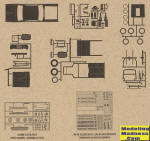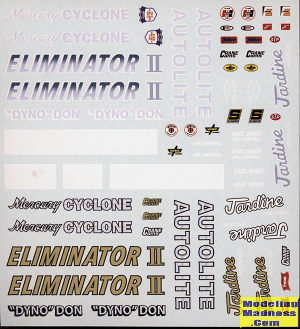
AMT 1/25 'Dyno' Don Nicholson's Eliminator II
| KIT #: | 1151 |
| PRICE: | $21.00 SRP |
| DECALS: | Two Options |
| REVIEWER: | Scott Van Aken |
| NOTES: | 2019 release |

| HISTORY |
Nicholson became nationally known to drag racing fans when he won the Stock class at NHRA's first Winternationals in 1961 with a 12-second pass; he and Ronnie Sox raced the only two Chevrolets, when Fords were the standard. The win helped his business in Southern California, and gave him access to factory-developed Chevrolets and special racing parts. He repeated as the 1962 Winternationals winner. He received lucrative offers from promoters in the Southeastern United States, so moved to Atlanta to compete in match races. Chevrolet and the other American car manufacturers decided to drop their factory backing in 1963 and his vehicle became uncompetitive. He switched to a Mercury Comet for 1964 in the A/Factory Experimental (A/FX) class. He won over 90 percent of match races he entered that year. That year he made the first 10-second pass in a doorslammer, as well as being the first driver to lift the front wheels when he shifted gears.
In 1965, Dodge and Plymouth teams moved their front and rear wheels forward, giving them greater traction. These new "funny cars" were not allowed in NHRA meets. Ford disallowed their factory-supported Ford and Mercury teams competing against these new Mopar funny cars. Nicholson was concerned about losing his match racing income since his car was outclassed. That August, he converted his steel-bodied four-speed car to ah A/FX, switching to nitromethane and fuel injection and moving the rear axle forward 12 in (30 cm). Several weeks later, he defeated the Ramcharger Dodge, the top Mopar entry, with a 9.30 second pass at 150 mph (240 km/h).
Mercury commissioned a new tube chassis Comet for 1966. The Logghe Bros.-built car featured a one piece flip-top body. Nicholson's car, Eliminator I, was rarely defeated that season. It clocked the first 7-second e.t. in Funny Car at Michigan in the second half of 1966. The only driver capable of defeating Eliminator I was Nicholson's teammate Eddie Schartman. Nicholson was so dominant, critics predicted the demise of the new Funny Car "craze". He enjoyed another highly successful year in Eliminator II in 1967, until other teams started adding superchargers late in the year. Other teams had run superchargers before, but by the middle of 1967, tire technology had caught up to the power produced by these cars and they began to "hook up" better rather than just spin the tires. Nicholson started the 1968 season with his now-supercharged Comet. He won the Irwindale New Year's Day race, where he qualified number two with a 8.03 and went on to set low e.t. of the meet at 7.99, and won the event. At the AHRA meet at Lion's Dragway in January, he qualified number one (low e.t.) with a strong 7.63 but failed to win the meet. He did win the second annual Stardust National Open, beating Schartman in the final round, with a 7.83 pass, low e.t. of the meet. Most of Nicholson's earnings at this time came from match race competition.
| THE KIT |
 This
particular variation of the 67 Comet was released in 1968 and later in 1975,
both with different decals. This boxing is of 2019 origin and allows something
close to the Eliminator II to be built. I say close as looking at photos of the
real deal, you'll spot a fairly obvious difference or two.
This
particular variation of the 67 Comet was released in 1968 and later in 1975,
both with different decals. This boxing is of 2019 origin and allows something
close to the Eliminator II to be built. I say close as looking at photos of the
real deal, you'll spot a fairly obvious difference or two.
It is a pretty simple kit as things go. A one piece body with separate hood, grille and bumpers is included. For some reason both a red and clear window piece is provided. It has a nice chassis onto which an interior assembly is attached. This assembly includes the dash, seat steering wheel and a roll bar.
The main chassis pan is used to attach the front and
rear suspension bits. Typical of these cars, the front uses leaf springs and there are wheelie bars
for the rear. There is no rear axle as apparently the rear wheels simply glue in
place. Tires are plastic and consist of two pieces onto which the wheels are
fit. A fairly complete engine, complete with blower and exhaust is provided to
fit into the forward section. After that the major chrome bits are attached.
Pivots are provided for the rear of the body and in the front is a support. The
chrome sprue is well done, though not all that much was actually chrome on this
car so you may wish to strip many of the parts and paint them aluminum.
Typical of these cars, the front uses leaf springs and there are wheelie bars
for the rear. There is no rear axle as apparently the rear wheels simply glue in
place. Tires are plastic and consist of two pieces onto which the wheels are
fit. A fairly complete engine, complete with blower and exhaust is provided to
fit into the forward section. After that the major chrome bits are attached.
Pivots are provided for the rear of the body and in the front is a support. The
chrome sprue is well done, though not all that much was actually chrome on this
car so you may wish to strip many of the parts and paint them aluminum.
Instructions are just like what you got in the 60s when this kit was released. All painting is in generic colors. The decal sheet provides two different variations on what the car wore. There is no placement guide so you'll need to rely on the box top and period photos of the car for proper placement. Fortunately, they are easy to find. The sheet looks to be quite nicely printed.
| CONCLUSIONS |
In all, it appears to be a kit that will be fairly easy to build and the end result will be a nice model. Those who wish to make it more accurate, can do so as the mods appear to be pretty straighforward.
| REFERENCES |
https://en.wikipedia.org/wiki/Don_Nicholson
February 2024 Copyright ModelingMadness.com. All rights reserved. No
reproduction in part or in whole without express permission from the editor.
If you would like your product reviewed fairly and fairly quickly, please
contact the editor or see other details in the
Note to
Contributors.